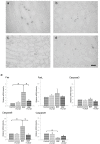Gosha-Jinki-Gan Recovers Spermatogenesis in Mice with Busulfan-Induced Aspermatogenesis
- PMID: 30177609
- PMCID: PMC6165450
- DOI: 10.3390/ijms19092606
Gosha-Jinki-Gan Recovers Spermatogenesis in Mice with Busulfan-Induced Aspermatogenesis
Abstract
Busulfan is an anti-cancer chemotherapeutic drug and is often used as conditioning regimens prior to bone marrow transplant for treatment of chronic myelogenous leukemia. Male infertility, including spermatogenesis disturbance, is known to be one of the side effects of anticancer drugs. While hormone preparations and vitamin preparations are used for spermatogenesis disturbance, their therapeutic effects are low. Some traditional herbal medicines have been administered to improve spermatogenesis. In the present study, we administered Gosha-jinki-gan (TJ107; Tsumura Co., Ltd., Tokyo, Japan) to mice suffering from severe aspermatogenesis after busulfan treatment to determine whether TJ107 can recover spermatogenesis. Male 4-week-old C57BL/6J mice were administered a single intraperitoneal injection of busulfan, and they were then fed a normal diet for 60 days and then a TJ107 diet or TJ107-free normal diet for another 60 days. After busulfan treatment, the weight of the testes and the epididymal sperm count progressively decreased in the normal diet group. On the other hand, in the TJ107 group, these variables dramatically recovered at 120 days. These results suggest that busulfan-induced aspermatogenesis is irreversible if appropriate treatment is not administered. Supplementation of TJ107 can completely recover the injured seminiferous epithelium via normalization of the macrophage migration and reduction of the expressions of Tool-like receptor (TLR) 2 and TLR4, suggesting that TJ107 has a therapeutic effect on busulfan-induced aspermatogenesis.
Keywords: anticancer treatment; aspermatogenesis; oriental medicine; testicular immunology.
Conflict of interest statement
All the authors have no conflicts of interest to declare.
Figures






Similar articles
-
Effect of Gosha-Jinki-Gan on Levels of Specific mRNA Transcripts in Mouse Testes after Busulfan Treatment.Biomedicines. 2020 Oct 19;8(10):432. doi: 10.3390/biomedicines8100432. Biomedicines. 2020. PMID: 33086656 Free PMC article.
-
Co-Administration of the Traditional Medicines Hachimi-Jio-Gan and Hochu-Ekki-To Can Reverse Busulfan-Induced Aspermatogenesis.Int J Mol Sci. 2020 Mar 3;21(5):1716. doi: 10.3390/ijms21051716. Int J Mol Sci. 2020. PMID: 32138301 Free PMC article.
-
The effectiveness of traditional Japanese medicine Goshajinkigan in irradiation-induced aspermatogenesis in mice.BMC Complement Altern Med. 2019 Dec 11;19(1):362. doi: 10.1186/s12906-019-2786-z. BMC Complement Altern Med. 2019. PMID: 31829240 Free PMC article.
-
Effect of Gosha-jinki-gan, a blended herbal medicine, on bladder activity in rats.J Urol. 2007 Feb;177(2):762-5. doi: 10.1016/j.juro.2006.09.077. J Urol. 2007. PMID: 17222677
-
Pharmacological Effects and Immune Mechanisms of Oriental Medicines in Restoring Male Infertility.Int J Mol Sci. 2025 May 13;26(10):4642. doi: 10.3390/ijms26104642. Int J Mol Sci. 2025. PMID: 40429786 Free PMC article. Review.
Cited by
-
Modeling methods for busulfan-induced oligospermia and asthenozoospermia in mice: a systematic review and meta-analysis.J Assist Reprod Genet. 2023 Jan;40(1):19-32. doi: 10.1007/s10815-022-02674-y. Epub 2022 Dec 12. J Assist Reprod Genet. 2023. PMID: 36508035 Free PMC article.
-
Changes in Expression of Specific mRNA Transcripts after Single- or Re-Irradiation in Mouse Testes.Genes (Basel). 2022 Jan 15;13(1):151. doi: 10.3390/genes13010151. Genes (Basel). 2022. PMID: 35052491 Free PMC article.
-
Effects of Chemotherapy and Radiotherapy on Spermatogenesis: The Role of Testicular Immunology.Int J Mol Sci. 2019 Feb 22;20(4):957. doi: 10.3390/ijms20040957. Int J Mol Sci. 2019. PMID: 30813253 Free PMC article. Review.
-
Role of Antioxidant Natural Products in Management of Infertility: A Review of Their Medicinal Potential.Antioxidants (Basel). 2020 Oct 7;9(10):957. doi: 10.3390/antiox9100957. Antioxidants (Basel). 2020. PMID: 33036328 Free PMC article. Review.
-
Effect of Gosha-Jinki-Gan on Levels of Specific mRNA Transcripts in Mouse Testes after Busulfan Treatment.Biomedicines. 2020 Oct 19;8(10):432. doi: 10.3390/biomedicines8100432. Biomedicines. 2020. PMID: 33086656 Free PMC article.
References
-
- Ploemacher R.E., Johnson K.W., Rombouts E.J., Etienne K., Westerhof G.R., Baumgart J., White-Scharf M.E., Down J.D. Addition of treosulfan to a nonmyeloablative conditioning regimen results in enhanced chimerism and immunologic tolerance in an experimental allogeneic bone marrow transplant model. Biol. Blood Marrow Transplant. 2004;10:236–245. doi: 10.1016/j.bbmt.2003.11.004. - DOI - PubMed
-
- Kenis Y., Dustin P., Henry J.A., Tagnon H.J. Action du Myleran dans 22 cas de leucemie myeloide chromique. Rev. Fr. Etud. Clin. Biol. 1956;1:435–442. - PubMed
MeSH terms
Substances
LinkOut - more resources
Full Text Sources
Other Literature Sources

